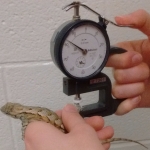Not all of the lab went south this summer; Kristen (one of our awesome lab undergrads) and I stayed at Penn State most of the summer, working on immune assays. Kristen was the recipient of the Erickson Discovery Grant, and spent much of her summer on an independent research project, which involved measuring the effects of corticosterone (CORT) on the cell-mediated immunity (i.e. one way the body responds to a toxic or foreign substance) of eastern fence lizard females. She was also trying to determine if the lizards’ life history (whether they were from sites with or without fire ants) affected their immune function or interacted with the CORT treatment. Kristen just recently gave an excellent talk on her research at the Three Rivers Evolution Event (TREE) on Sept. 9th, where she was one of the only undergraduates to present a talk.
We also spent a lot of time this summer developing, improving, and validating several different immune assays for use in fence lizards, including ELISA assays for measuring anti-fire ant antibodies (IgY and IgM), complement function, natural antibodies, and the activity levels of heterophils (a type of immune cell that kills bacteria). Work on the assays for IgY, complement function, and natural antibodies is ongoing, but the IgM and heterophil activity assays are ready to be used.
The IgM ELISA assay was developed to work with as little as 10μl of plasma, and accurately detected anti-fire ant antibodies in a pool of plasma of lizards from Alabama, where the lizards are regularly exposed to fire ants. It did not detect any antibodies in a pool of plasma of lizards from Tennessee, at sites which have not yet been invaded by fire ants. The next step is to test the plasma of individual lizards from different sites, to see what proportion of lizards in various invaded sites have actually developed IgM antibodies to fire ants. Once the IgY assay is working, we should be able to better characterize the antibody response of the lizards to fire ants, and see if this helps them recover faster from fire ant stings.

The higher the proportion of plasma from invaded (Alabama) lizards, the higher the signal from the IgM antibody.
Our heterophil activity assay is based off the assay described in Merchant, Williams, and Hardy (2009) for use in American alligators. To account for the much smaller blood volume of fence lizards, I altered the assay to work with 10μl of whole blood, and validated it in this species. This assay specifically tests for the presence of superoxide radicals, which are produced by heterophils as part of the oxidative burst used to kill bacteria and other organisms. When heterophils are more active (either because there are more heterophils or because the existing heterophils have been stimulated by something), the amount of superoxide in the blood increases. As part of the validation, we ran the assay with pools of blood treated with superoxide dismutase, which destroys superoxide, to test that the signal is actually caused by superoxide. We also ran blood with and without a stimulant of heterophil function, to determine if the signal reliably increases when heterophils are more active. The signal reliably decreases when inhibited by superoxide dismutase, and reliably increases when stimulant is added, indicating that this is a reliable test of heterophil function.
We also did a little bit of work optimizing the natural antibody test, increasing the sensitivity of the test so that it will work with less lizard plasma. And we also found a promising lead for testing alternative pathway complement function in fence lizards.
Aside from all the immunology work, we also got out into the field up here in Pennsylvania a little bit, although we didn’t find many lizards. All in all, it was a fun, productive summer.






